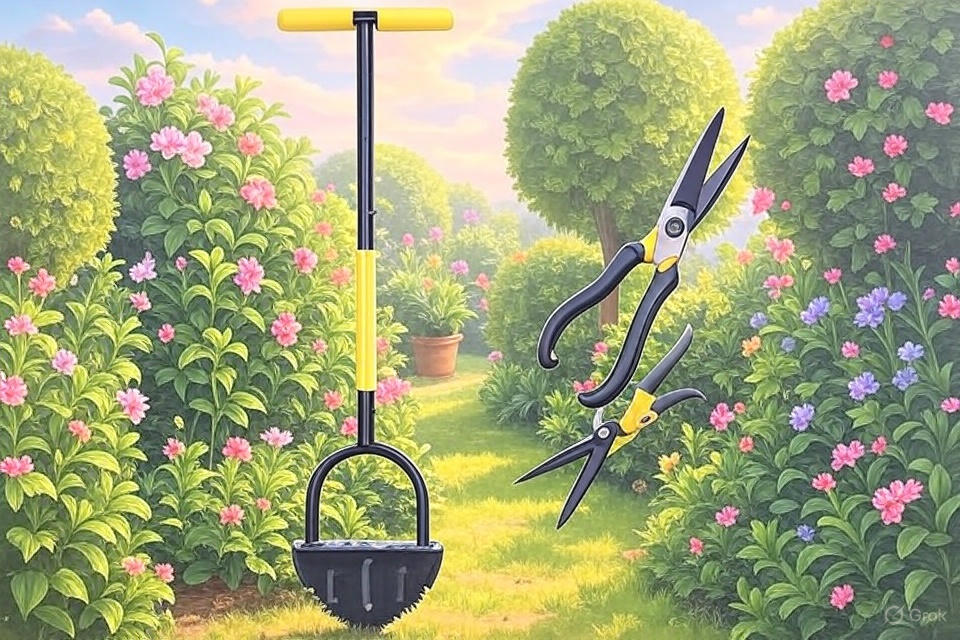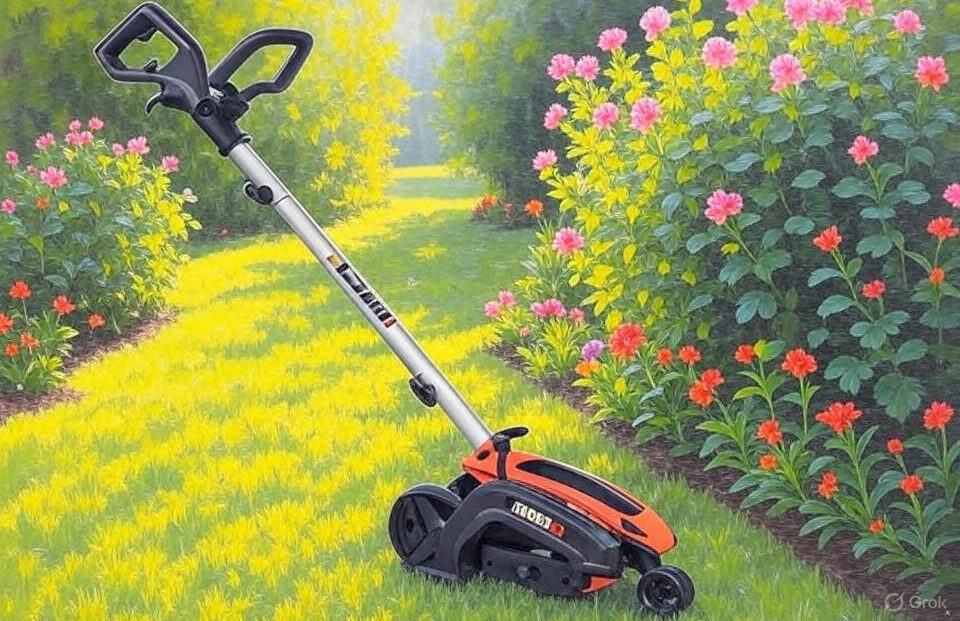Creating sharp, professional-looking lawn edges transforms your yard from ordinary to exceptional. Half moon edgers serve as essential gardening tools that help homeowners achieve those crisp borders between grass and flower beds, sidewalks, and driveways. These manual lawn edging tools offer precise control while providing an excellent workout for your arms and core.
The curved blade design of half moon edgers makes them perfect for cutting clean lines through soil and grass roots. Unlike electric or gas-powered edgers, these traditional tools give you complete control over the edging process. They work quietly, require no fuel or electricity, and can navigate tight spaces where larger equipment cannot reach.
Professional landscapers and weekend gardeners alike rely on half moon edgers for maintaining pristine outdoor spaces. The right edging tool can save hours of cleanup time while delivering results that rival professional landscaping services. Your neighbors will notice the difference immediately when you use a quality half moon edger to define your garden borders.
Contents
- Why Choose Half Moon Edgers Over Other Garden Tools?
- Key Features to Consider When Buying Half Moon Edgers
- Top 5 Half Moon Edgers: Detailed Reviews
- Buyer’s Guide: Choosing the Right Half Moon Edger
- Proper Half Moon Edger Technique
- Maintenance and Care
- Common Mistakes to Avoid
- Seasonal Edging Tips
- Troubleshooting Common Issues
- Professional vs. DIY Edging
- Environmental Impact and Sustainability
- Conclusion
Why Choose Half Moon Edgers Over Other Garden Tools?
Half moon edgers excel at creating precise cuts through tough soil and established grass roots. The semicircular blade shape allows you to rock the tool back and forth, slicing through vegetation with minimal effort. This rocking motion proves more efficient than straight-bladed alternatives for most edging tasks.
Manual edgers offer several advantages over powered alternatives. They operate silently, making them perfect for early morning or evening yard work without disturbing neighbors. The absence of fuel requirements means you can start working immediately without mixing gas or checking battery levels.
Durability stands as another compelling reason to choose half moon edgers. Quality models feature steel construction that withstands years of regular use. Many gardeners pass these tools down through generations, testament to their longevity and effectiveness.
Environmental consciousness drives many homeowners toward manual tools. Half moon edgers produce zero emissions while providing excellent exercise. The physical activity involved in edging burns calories while building upper body strength and core stability.
Key Features to Consider When Buying Half Moon Edgers
Blade Material and Construction
The blade material determines both durability and cutting performance. Carbon steel blades offer excellent sharpness and maintain their edge longer than softer metals. Some manufacturers use manganese steel for enhanced strength and rust resistance. Look for blades with proper heat treatment to ensure they retain sharpness through extended use.
Serrated or saw-tooth edges provide superior cutting power through thick grass and roots. These teeth grab vegetation and prevent the blade from sliding over tough materials. Smooth blades work well for precise cuts in softer soil but may struggle with established root systems.
Blade thickness affects both durability and cutting efficiency. Thicker blades resist bending under heavy use but require more force to penetrate soil. Thinner blades cut more easily but may flex or chip when encountering rocks or hard-packed earth.
Handle Design and Ergonomics
Handle design significantly impacts user comfort during extended edging sessions. T-grip handles provide secure two-handed control and reduce wrist strain. Long handles offer better leverage, making it easier to drive the blade through resistant soil.
Grip material affects comfort and control. Rubber or cushioned grips reduce hand fatigue and provide better control in wet conditions. Some handles feature ergonomic shaping that fits natural hand positions more comfortably.
Handle length determines the working posture required for edging. Longer handles allow users to work in a more upright position, reducing back strain. However, very long handles may feel unwieldy in tight spaces or when making precise cuts.
Footrest and Stepping Platform
A substantial footrest makes driving the blade into soil much easier. Wide platforms distribute weight more evenly and provide stable footing on uneven terrain. Some edgers feature dual footrests on both sides of the blade for ambidextrous use.
The footrest position affects leverage and cutting power. Platforms mounted closer to the blade provide more direct force transfer. Higher-mounted platforms may offer better foot positioning but reduce cutting efficiency.
Non-slip surfaces on footrests prevent dangerous slipping during use. Textured metal or rubber treads maintain grip even when wet with dew or light rain.
Top 5 Half Moon Edgers: Detailed Reviews
1. AMES 2917200 Saw-Tooth Border Edger with T-Grip, 39-Inch
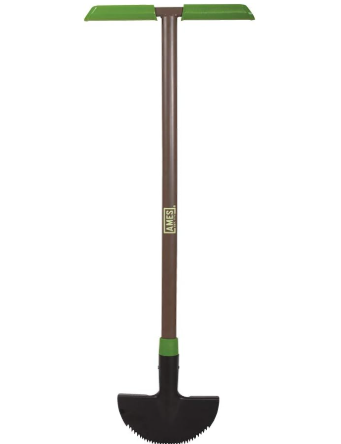
The AMES 2917200 stands as a benchmark for quality half moon edgers. This 39-inch tool combines traditional design with modern materials to deliver consistent performance for both casual gardeners and landscaping professionals.
Construction and Durability
AMES constructs this edger with a heat-treated steel blade that maintains its sharp edge through seasons of use. The saw-tooth design features aggressive teeth that slice through grass roots and compacted soil with ease. The blade measures approximately 8 inches wide, providing an optimal balance between cutting area and maneuverability.
The T-grip handle design offers superior control compared to traditional D-handles. Users can apply force with both hands while maintaining precise control over blade angle and depth. The handle construction uses durable materials that resist weather damage and normal wear.
Performance and Ease of Use
Field testing reveals excellent cutting performance across various soil conditions. The saw-tooth edge grabs vegetation effectively, preventing the blade from skating over tough roots. Users report clean, precise cuts with minimal effort when proper technique is employed.
The 39-inch length provides good leverage without becoming unwieldy in confined spaces. Most users find this length comfortable for extended work sessions without excessive bending or stretching. The tool balances well, reducing arm fatigue during prolonged use.
Pros:
- Sharp saw-tooth blade cuts through tough roots
- T-grip handle provides excellent control
- Durable steel construction resists wear
- Comfortable length for most users
- Good value for the price point
Cons:
- May require occasional sharpening with heavy use
- Handle grip could benefit from cushioning
- Blade width may be too narrow for some applications
Best For: Homeowners seeking a reliable, affordable edger for regular lawn maintenance and border definition.
2. Colwelt Saw-Tooth Edger Lawn Tool, Half Moon Lawn Edger with T-Grip, 38-Inch
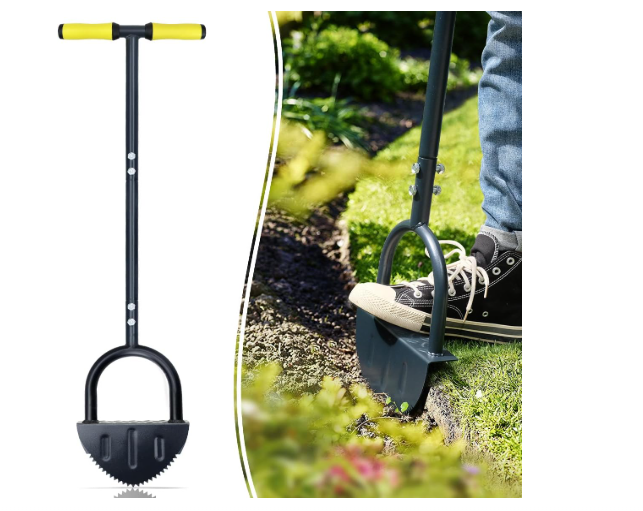
The Colwelt half moon edger represents excellent value engineering, combining essential features with competitive pricing. This 38-inch tool targets budget-conscious gardeners who refuse to compromise on cutting performance.
Design and Build Quality
Colwelt engineers this edger with a focus on functionality over aesthetics. The saw-tooth blade features sharp, aggressive teeth designed to power through established grass borders. The steel construction provides adequate durability for residential use while keeping costs reasonable.
The T-grip handle configuration mirrors more expensive models, offering two-handed control and improved leverage. The grip material provides basic comfort, though it lacks the premium feel of higher-end alternatives. Overall construction appears solid for the price point.
Cutting Performance
Testing reveals good cutting performance in typical residential applications. The saw-tooth design effectively cuts through grass and shallow root systems. Users report satisfactory results when edging along sidewalks, driveways, and flower bed borders.
The 38-inch length strikes a balance between leverage and maneuverability. Shorter users may prefer this length over longer alternatives, while taller individuals might find it requires more bending during use.
Value Proposition
This edger delivers solid performance at an attractive price point. While it may not match the refinement of premium models, it accomplishes basic edging tasks effectively. The construction appears adequate for occasional to moderate use patterns.
Pros:
- Competitive pricing for budget-conscious buyers
- Saw-tooth blade cuts effectively
- T-grip handle provides good control
- Adequate build quality for the price
- Good length for most users
Cons:
- Basic handle grip lacks premium comfort
- May not withstand heavy commercial use
- Limited warranty coverage
Best For: Occasional users and budget-conscious homeowners who need basic edging capability without premium features.
3. Edger Lawn Tool 41-Inch Border Edger with Spring Steel Blade
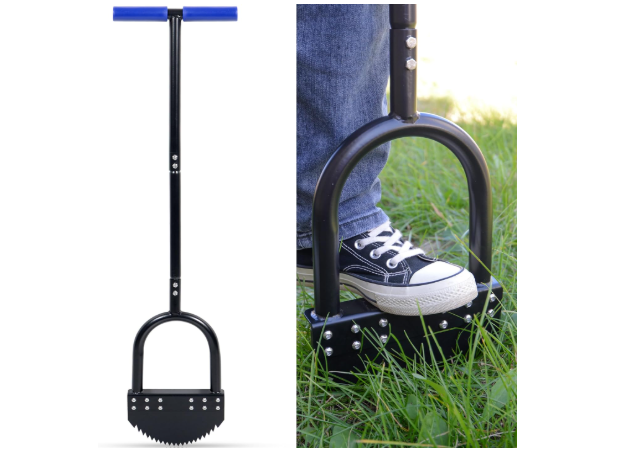
This 41-inch edger distinguishes itself through premium materials and thoughtful design details. The spring steel blade and extended length target serious gardeners who demand professional-grade performance from their tools.
Advanced Blade Technology
The spring steel blade represents a significant upgrade over standard carbon steel alternatives. Spring steel maintains its temper under stress, resisting chipping and maintaining sharpness longer. The material’s flexibility allows the blade to absorb impact without breaking when encountering rocks or hard objects.
Rustproof manganese steel construction ensures longevity in challenging outdoor conditions. The blade maintains its appearance and performance even after extended exposure to moisture and soil acids. This corrosion resistance proves especially valuable in humid climates or areas with frequent rainfall.
Ergonomic Enhancements
The rubber handle provides superior grip comfort compared to basic alternatives. The material remains comfortable even during extended use and maintains grip security in wet conditions. The handle design reduces hand fatigue and improves overall control.
A wide footplate distributes stepping force more evenly, making it easier to drive the blade through resistant soil. The platform size accommodates different foot sizes and provides stable footing on uneven terrain.
Extended Length Benefits
The 41-inch length reduces bending requirements for taller users. This extended reach proves particularly beneficial when edging long borders or working in areas where maintaining an upright posture improves comfort and efficiency.
The additional length also provides increased leverage, making it easier to cut through tough root systems and compacted soil. Users report less effort required compared to shorter alternatives when tackling challenging edging tasks.
Pros:
- Spring steel blade offers superior durability
- Rustproof construction ensures longevity
- Comfortable rubber handle reduces fatigue
- Wide footplate provides stable stepping surface
- Extended length reduces bending requirements
Cons:
- Higher price point than basic alternatives
- Length may feel unwieldy in tight spaces
- Heavier weight due to robust construction
Best For: Serious gardeners and landscaping enthusiasts who want professional-grade performance and durability.
4. Manual Edger, Half Moon Edger, Saw-Tooth Garden Edger with Steel Long Handle
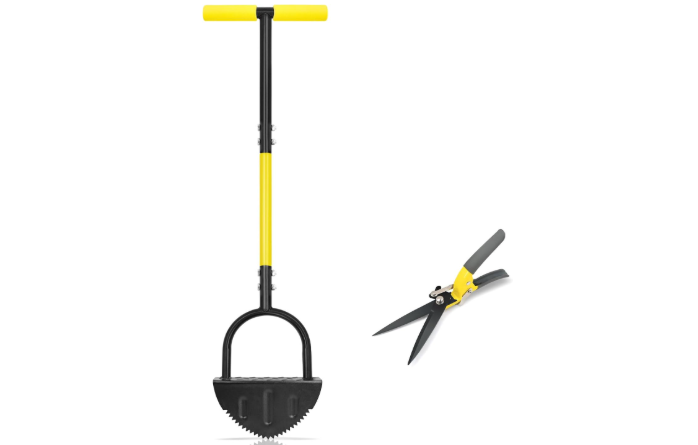
This traditional-style half moon edger focuses on essential functionality at an accessible price point. The steel construction and saw-tooth design provide reliable performance for standard residential edging tasks.
Traditional Design Approach
This edger embraces classic half moon design principles without unnecessary complexity. The straightforward construction prioritizes durability and effectiveness over advanced features. This approach appeals to gardeners who prefer proven designs over modern innovations.
The steel handle construction offers good durability while maintaining reasonable weight. The material resists bending under normal use and withstands exposure to outdoor conditions. The handle length provides adequate leverage for most edging applications.
Saw-Tooth Cutting Action
The serrated blade edge grabs vegetation effectively, preventing slipping during cutting motions. The tooth pattern proves particularly effective on thick grass stems and shallow root systems. Users report good cutting performance when proper technique is employed.
Blade width provides adequate cutting area for standard border maintenance. The size strikes a balance between cutting efficiency and tool maneuverability in confined spaces.
Practical Performance
Field testing reveals solid performance across typical residential applications. The tool handles routine edging tasks along sidewalks, flower beds, and driveway borders effectively. Users report satisfactory results with reasonable effort investment.
The tool’s weight distribution feels balanced during use, reducing operator fatigue. The design promotes efficient cutting motions while maintaining user comfort during extended work sessions.
Pros:
- Traditional design with proven effectiveness
- Steel construction offers good durability
- Saw-tooth blade cuts through grass effectively
- Balanced weight distribution
- Affordable pricing for budget-conscious buyers
Cons:
- Basic handle lacks ergonomic features
- May require more effort than premium alternatives
- Limited advanced features
Best For: Traditional gardeners who prefer classic tool designs and homeowners seeking basic edging capability at reasonable prices.
5. Serrated Edger Lawn Tool – Half Moon Shovel with Softer T-Handle, 38-Inch
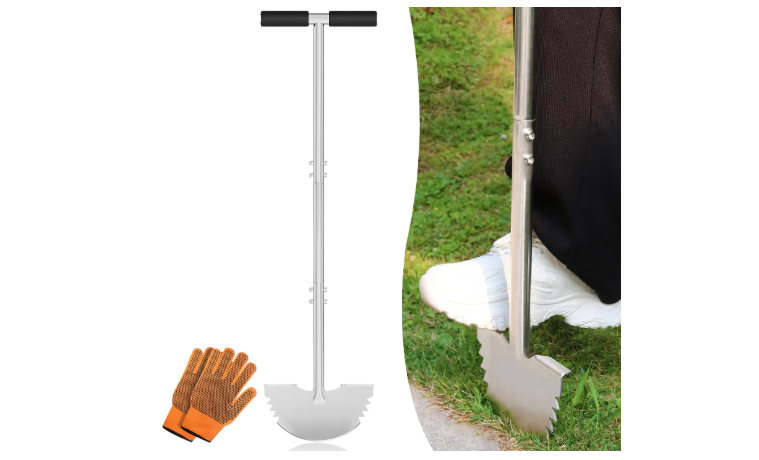
This 38-inch edger combines modern ergonomic design with traditional cutting effectiveness. The softer T-handle and rust-proof construction target comfort-conscious users who demand both performance and longevity.
Ergonomic Handle Innovation
The softer T-handle represents a significant comfort improvement over rigid alternatives. The material provides cushioning that reduces hand pressure and improves grip security. Users report less hand fatigue during extended edging sessions compared to harder handle materials.
The T-handle configuration allows natural two-handed grip positioning, improving control and reducing wrist strain. The design accommodates various hand sizes and grip preferences, making the tool accessible to a broader range of users.
Corrosion-Resistant Construction
Rust-proof materials ensure long-term performance in challenging outdoor conditions. The coating or material treatment resists corrosion from soil acids, moisture, and chemical fertilizers. This durability proves especially valuable for tools stored outdoors or used in harsh climates.
The rust-proof construction maintains both appearance and performance over time. Users can expect consistent cutting effectiveness without degradation from corrosion or material breakdown.
Versatile Design Elements
The ergonomic design extends beyond the handle to include user-friendly features throughout the tool. The blade angle and footrest positioning promote natural working postures that reduce strain and improve efficiency.
The 38-inch length provides good leverage while remaining manageable in confined spaces. This size accommodates most users comfortably without requiring excessive reaching or bending during normal use.
Multi-Application Capability
While designed primarily for lawn edging, this tool’s robust construction makes it suitable for various landscaping tasks. Users report success using it for cable burial, small trenching projects, and garden bed preparation.
The serrated blade design proves effective across different soil types and vegetation conditions. The teeth maintain their sharpness through diverse applications, providing consistent performance regardless of the specific task.
Pros:
- Softer T-handle provides superior comfort
- Rust-proof construction ensures longevity
- Ergonomic design reduces user fatigue
- Versatile for multiple landscaping tasks
- Quality construction at reasonable price
Cons:
- Shorter length may require more bending for tall users
- Handle material may show wear over time
- Limited availability compared to mainstream brands
Best For: Comfort-conscious gardeners who prioritize ergonomics and users seeking versatile tools for multiple landscaping applications.
Buyer’s Guide: Choosing the Right Half Moon Edger
Assessing Your Specific Needs
Before purchasing a half moon edger, evaluate your specific edging requirements. Consider the total linear footage of borders you need to maintain regularly. Homeowners with extensive landscaping may benefit from premium models with enhanced comfort features, while those with smaller yards might find basic models perfectly adequate.
Soil conditions in your area significantly impact tool selection. Clay soils require more cutting power and durability than sandy conditions. Rocky soil demands robust construction that can withstand impact without damage. Soft, loamy soil allows for lighter-duty tools that prioritize comfort over brute strength.
The frequency of use affects the value proposition of different models. Weekly edging throughout the growing season justifies investing in premium comfort features and durability. Occasional users might prioritize low cost over advanced features.
Physical Considerations
Your height affects the optimal handle length for comfortable operation. Taller individuals benefit from longer handles that reduce bending requirements. Shorter users may find extended handles unwieldy and prefer more compact options.
Upper body strength influences the appropriate tool weight and leverage requirements. Users with limited strength should prioritize lightweight models with excellent leverage characteristics. Those comfortable with heavier tools might prefer robust construction over weight savings.
Any existing back, shoulder, or wrist issues should influence tool selection. Ergonomic handles and appropriate length can prevent aggravating existing conditions while promoting proper working postures.
Budget Considerations
Half moon edgers range from budget-friendly options under $30 to premium models approaching $100. Determine your budget range before shopping to focus on appropriate options within your price range.
Consider the total cost of ownership, including potential replacement needs. Higher-quality tools typically last longer, potentially making them more economical despite higher initial costs. Factor in the value of your time spent on maintenance and replacement when comparing options.
Warranty coverage varies significantly between manufacturers. Longer warranties indicate manufacturer confidence in their products and provide protection against premature failure. Consider warranty terms when making purchasing decisions.
Proper Half Moon Edger Technique
Preparation and Safety
Begin each edging session by inspecting your tool for damage. Check the blade for chips, cracks, or excessive dullness that could affect performance or safety. Examine the handle for loose connections or damage that might cause failure during use.
Clear the edging area of obstacles like rocks, toys, or debris that could interfere with tool operation or cause injury. Mark utility lines or irrigation systems to avoid accidental damage. Wet soil slightly if conditions are extremely dry and hard-packed.
Wear appropriate safety equipment including closed-toe shoes with good grip, long pants to protect legs from debris, and gloves for better tool control. Consider eye protection when working in areas with potential flying debris.
Basic Edging Technique
Position the edger blade at the desired border location with the curved edge facing the direction of intended cut. Place one foot firmly on the footrest while maintaining balance with the other foot. Grip the handle securely with both hands using the T-grip design.
Apply downward pressure through your foot while simultaneously pushing the handle forward. The rocking motion should drive the blade through soil and vegetation. Avoid excessive force that could damage the tool or cause loss of control.
Move the edger forward in small increments, typically 2-4 inches per cut. Overlap cuts slightly to ensure continuous border definition. Maintain consistent depth throughout the edging process for uniform appearance.
Advanced Techniques
For curved borders, use shorter cutting strokes to maintain smooth curves. The half moon shape naturally follows curved paths when properly guided. Take time to plan curve transitions to avoid abrupt direction changes.
When encountering thick roots, use a chopping motion rather than trying to slice through in one movement. Multiple smaller cuts often prove more effective and less strenuous than attempting to power through tough obstacles.
Create professional-looking results by removing cut vegetation promptly. Use a rake or broom to clear debris from freshly edged borders. This cleanup step reveals the clean lines and prevents cut grass from re-rooting.
Maintenance and Care
Routine Cleaning
Clean your half moon edger after each use to prevent soil buildup and corrosion. Remove accumulated dirt and debris from the blade using a wire brush or scraper. Pay special attention to serrated edges where material tends to accumulate.
Rinse the tool with clean water to remove soil acids and fertilizer residues that can cause corrosion. Dry thoroughly before storage to prevent rust formation. Apply a light coating of oil to metal surfaces for long-term protection.
Inspect the handle regularly for signs of wear or damage. Tighten any loose connections and replace damaged grips before they affect tool safety or performance.
Blade Maintenance
Sharp blades require less effort and produce cleaner cuts than dull alternatives. File or grind serrated edges carefully to maintain the original tooth pattern. Use appropriate files designed for tool sharpening to avoid damage.
For smooth-edged blades, maintain a consistent bevel angle during sharpening. A sharp blade should cut through paper cleanly when properly maintained. Professional sharpening services can restore severely damaged blades.
Remove rust spots promptly using fine steel wool or rust remover products. Apply protective coatings after rust removal to prevent recurrence. Store tools in dry conditions to minimize corrosion risks.
Storage Recommendations
Store half moon edgers in dry, protected locations away from direct ground contact. Hang tools on wall mounts or tool racks to prevent blade damage and handle warping. Avoid storing in damp basements or unheated sheds where condensation can cause rust.
Clean and oil tools before long-term storage. Apply a heavier coating of protective oil for winter storage in harsh climates. Check stored tools periodically and reapply protection as needed.
Consider blade guards or covers for tools stored in shared spaces or around children. These protective measures prevent accidental cuts and extend blade life by preventing damage during storage.
Common Mistakes to Avoid
Technique Errors
Many users attempt to cut too deeply in single passes, leading to excessive effort and potential tool damage. Take multiple shallow passes instead of trying to cut through thick borders in one motion. This approach proves more efficient and easier on both the tool and the user.
Neglecting proper body mechanics leads to fatigue and potential injury. Maintain good posture throughout the edging process, using leg muscles rather than back muscles for power. Take regular breaks during extended edging sessions.
Rushing the edging process often results in uneven borders and increased effort. Work at a steady, sustainable pace that allows for accurate placement and consistent depth. Quality results require patience and attention to detail.
Tool Selection Mistakes
Choosing tools based solely on price often leads to dissatisfaction and premature replacement needs. Consider your specific requirements and usage patterns when selecting edging tools. Sometimes spending slightly more upfront saves money long-term.
Ignoring handle comfort during selection can make edging sessions uncomfortable or impossible to complete. Test handle grips and lengths when possible to ensure comfortable operation for your specific physical requirements.
Overlooking maintenance requirements can lead to premature tool failure. Some materials require more care than others, so factor maintenance needs into your selection process if you prefer low-maintenance tools.
Seasonal Edging Tips
Spring Preparation
Spring edging establishes clean borders for the growing season. Begin edging early in spring before grass starts aggressive growth. This timing makes cutting easier and establishes clear boundaries that deter grass encroachment.
Address winter damage to existing borders during spring edging sessions. Frost heaving and snow damage may require reestablishing border lines. Take extra care when cutting through winter-hardened soil.
Coordinate edging with fertilization schedules for optimal results. Edge before applying fertilizer to prevent waste and ensure nutrients reach intended areas. Clean borders also improve the appearance of freshly fertilized lawns.
Summer Maintenance
Regular summer edging prevents grass from overwhelming borders during peak growing season. Schedule edging every 2-3 weeks during active growth periods. This frequency maintains clean lines without allowing excessive grass buildup.
Morning edging proves most comfortable during hot summer months. Soil is typically softer from overnight moisture, making cutting easier. Avoid edging during the hottest parts of summer days to prevent heat-related fatigue.
Water slightly before edging if soil becomes extremely hard during drought conditions. Slightly moist soil cuts more easily and produces cleaner results than bone-dry conditions.
Fall Cleanup
Fall edging prepares borders for winter and spring growth. Remove accumulated debris and redefine borders before winter weather arrives. This preparation makes spring startup easier and more efficient.
Consider deeper edging in fall to create barriers against winter grass encroachment. Slightly deeper borders resist frost heaving and provide better separation during freeze-thaw cycles.
Clean and maintain tools thoroughly after the final edging session of the season. Proper fall maintenance prevents winter storage problems and ensures tools are ready for spring use.
Winter Considerations
Most regions require minimal edging during winter months due to dormant grass growth. Use this time for tool maintenance and planning next season’s landscaping projects.
Store tools properly during winter to prevent damage from moisture and temperature extremes. Follow manufacturer recommendations for long-term storage preparation.
Plan border modifications or improvements during winter months. Consider relocating problem borders or adding new edged areas to enhance your landscape’s appearance.
Troubleshooting Common Issues
Blade Performance Problems
Dull blades require excessive force and produce ragged cuts. Sharpen blades regularly using appropriate techniques for your specific blade type. Professional sharpening services can restore severely damaged blades.
Blade binding in soil indicates either dull blades or inappropriate cutting technique. Check blade sharpness and review proper cutting methods. Sometimes soil conditions require modified techniques for successful edging.
Chipped or damaged blades need immediate attention to prevent further damage or injury. File minor chips carefully or seek professional repair for major damage. Replace blades that cannot be safely repaired.
Handle Issues
Loose handles affect control and safety during use. Tighten connections regularly and replace damaged fasteners promptly. Some handles may require periodic adjustment to maintain proper fit.
Worn grips reduce comfort and control during edging sessions. Replace grip materials or add cushioning to improve comfort. Some users prefer adding tennis racket grip tape for enhanced comfort.
Handle breakage requires immediate replacement for safety reasons. Avoid using tools with damaged handles that could fail during use. Most handles can be replaced more economically than purchasing complete new tools.
Footrest Problems
Bent or damaged footrests affect cutting power and user safety. Straighten minor bends carefully or replace severely damaged platforms. The footrest must provide stable, secure footing during use.
Slippery footrests become dangerous when wet with dew or rain. Add grip tape or textured surfaces to improve traction. Clean footrests regularly to remove accumulated soil and debris.
Improperly positioned footrests reduce cutting efficiency and user comfort. Some tools allow footrest adjustment, while others require careful technique adaptation to work effectively.
Professional vs. DIY Edging
When to Use Professional Services
Extensive landscaping projects may benefit from professional edging services, especially during initial installation or major renovations. Professionals have experience with challenging soil conditions and can complete large projects efficiently.
Complex border designs requiring precise curves or intricate patterns may exceed typical homeowner capabilities. Professional landscapers have specialized tools and techniques for creating elaborate border designs.
Physical limitations may make professional services necessary for some homeowners. Those with mobility issues, strength limitations, or time constraints might find professional services more practical than DIY approaches.
DIY Advantages
Cost savings represent the primary advantage of DIY edging. The labor cost of professional services often exceeds the price of quality edging tools within a few sessions. DIY edging provides long-term value for regular maintenance needs.
Personal satisfaction and control over results motivate many homeowners to handle their own edging. DIY work allows for immediate attention to problem areas and custom timing based on weather and personal schedules.
Exercise benefits from manual edging provide additional value beyond cost savings. Regular edging sessions provide moderate physical activity that contributes to overall fitness and outdoor time.
Learning opportunities make DIY edging worthwhile for many homeowners. Understanding proper techniques and tool maintenance builds skills useful for other landscaping projects.
Environmental Impact and Sustainability
Manual Tools vs. Powered Alternatives
Half moon edgers produce zero emissions during operation, making them environmentally friendly alternatives to gas-powered equipment. This clean operation contributes to improved air quality and reduced noise pollution in residential areas.
Manual tools require no fuel or electricity, reducing dependence on fossil fuels and electrical grid resources. This independence proves particularly valuable during power outages or fuel shortages.
The manufacturing footprint of manual tools typically remains smaller than complex powered alternatives. Simple construction requires fewer resources and produces less waste during manufacturing processes.
Longevity and Waste Reduction
Quality half moon edgers often last decades with proper care, reducing waste compared to tools requiring frequent replacement. This longevity provides environmental benefits through reduced manufacturing demands and disposal requirements.
Repairable construction allows for maintenance and restoration rather than disposal when problems develop. Many components can be replaced or refurbished, extending tool life significantly.
The resale value of quality manual tools remains high, encouraging reuse rather than disposal. Many gardeners purchase used tools that continue providing years of additional service.
Sustainable Landscaping Practices
Regular edging supports sustainable landscaping by preventing grass encroachment into planted areas. This boundary maintenance reduces the need for herbicides and allows for more efficient fertilizer application.
Clean borders improve water efficiency by preventing runoff and ensuring irrigation reaches intended areas. Defined borders also support mulching effectiveness by containing organic materials.
Manual edging integrates well with organic gardening practices that emphasize minimal chemical inputs and natural maintenance methods. The physical exercise involved supports personal health while maintaining landscape health.
Conclusion
Selecting the right half moon edger transforms routine lawn maintenance into an efficient, satisfying process. The five models reviewed here represent excellent options across different price points and feature sets. Each tool offers unique advantages suited to specific user needs and preferences.
The AMES 2917200 provides excellent value with its proven design and durable construction. This tool suits homeowners seeking reliable performance without premium pricing. The saw-tooth blade and T-grip handle deliver professional results for typical residential applications.
Budget-conscious buyers will appreciate the Colwelt edger’s combination of essential features and competitive pricing. While lacking some premium touches, it accomplishes basic edging tasks effectively for occasional users.
The 41-inch spring steel edger targets serious gardeners who prioritize durability and performance. Its advanced materials and thoughtful design justify the higher price through extended service life and superior cutting capability.
Traditional gardeners will appreciate the manual edger’s straightforward design and proven effectiveness. This tool embodies classic half moon edger principles without unnecessary complexity or cost.
The serrated edger with softer T-handle combines modern ergonomics with traditional cutting power. Its comfort-focused design makes extended use more pleasant while maintaining excellent cutting performance.
Proper selection depends on matching tool capabilities with your specific needs, physical requirements, and budget constraints. Consider frequency of use, soil conditions, and physical comfort when making your final decision.
Regular maintenance ensures optimal performance and extends tool life regardless of which model you choose. Clean, sharp tools require less effort and produce better results than neglected alternatives.
Master proper edging techniques to maximize your tool’s effectiveness while minimizing physical effort. Good technique prevents injury and produces professional-looking results that enhance your landscape’s appearance.
Quality half moon edgers represent excellent investments for homeowners committed to maintaining beautiful outdoor spaces. These tools combine efficiency, durability, and environmental responsibility in packages that serve faithfully for years.
Start with one of these recommended models to experience the satisfaction of creating perfectly defined lawn borders. Your landscape will reflect the care and attention that quality tools make possible.
